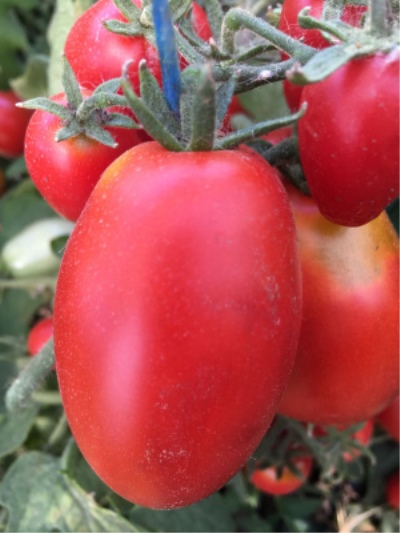
- Authors: Research Institute of Horticulture of Siberia, Barnaul
- Name synonyms: Phytophthora resistant
- Category: grade
- Growth type: determinant
- Appointment: universal
- Ripening period: mid-early
- Ripening time, days: 95-105
- Growing conditions: for open ground, for film greenhouses
- Bush size: undersized
- Bush height, cm: up to 50
A tomato with an unusual name Phytous appeared thanks to the efforts of experienced breeders in 1997. Although the variety appeared a long time ago, it is still in great demand among many vegetable growers. This variety has been cultivated for several decades due to its high resistance to diseases and other positive characteristics.
Description of the variety
The bushes feel great when choosing any growing condition, whether it be film greenhouses or open beds. A low-growing plant does not grow more than 0.5 m in height. The structure is compact. Given these characteristics, the variety can be cultivated in small areas and in low greenhouses.
Growth type is determinant. The main stem is erect and strong, branching is weak.
The type of inflorescence is simple. One fruit cluster grows from 5 to 8 tomatoes. The color of shoots and leaves is dark green. The first inflorescence develops over 7 or 8 leaves.
The main qualities of the fruit
During the fruiting period, the bush is covered with fruits of a light green color. By the time they reach maturity, they change color to a rich red. The color is uniform. Weight varies from 55 to 70 g. The shape is oval, pear-shaped.
The peel is smooth, glossy. It is moderately tough, but it is able to protect the crop from cracking. The pulp is firm. 2-3 seed chambers are formed inside.
The fruits are not afraid of long-term transportation and can be stored for a long time in suitable conditions. This is another feature thanks to which the Fitous variety has become widespread. Tomatoes can be grown commercially.
Taste characteristics
The taste is excellent. Ripe tomatoes are sweet and juicy. Ideal for salads, appetizers and other dishes.
Ripening and fruiting
Phytous is considered medium early. From the day of emergence to the formation of ripe vegetables, it takes from 95 to 105 days. The dates for harvesting fruits fall from July to September.
Yield
Vegetable growers who have been growing tomatoes for several years note the high yield of this variety. From m 2 beds, you can collect from 10 to 12 kg of fruit. When growing the variety on large land plots, the yield is from 80 to 100 tons per hectare.
The timing of planting seedlings and planting in the ground
In the last days of March or early April, they begin sowing seeds for seedlings. By the time it is planted in the ground, which occurs from late spring to early summer, the seedlings will be strong enough and ready to be transplanted to a new location. When choosing the exact time, you need to pay attention to the weather in the region and the method of cultivation. Seedlings can be transferred to greenhouses or hotbeds earlier than when grown outdoors.
This vegetable crop is propagated by the seedling method. For germination, you need to prepare the following:
- seed material;
- light and fertile soil that will allow water and oxygen to pass through;
- containers for growing and picking;
- phytolamps to provide plants with a sufficient amount of light;
- spray.
The seeds are deepened into the soil by no more than 1 cm. The soil is irrigated with a sprinkler as it dries. The container with seeds is covered with glass or foil. Over time, the seedlings dive into separate containers and continue to grow, providing access to sunlight to the plants.If natural lighting is not enough, additional lighting devices are used.

Growing tomato seedlings is an extremely important process, because it largely depends on whether the gardener can harvest at all. All aspects must be taken into account, from seedbed preparation to planting in the ground.
Landing scheme
The most common planting scheme is 50x40 cm. On one square. m planted no more than 3 bushes.

Growing and care
Before transferring the bushes to a new place, the selected area is prepared in advance. It is cleaned of debris, weeds and moistened. With increased acidity of the soil, it must be lowered. 10 g of superphosphate solution is sent to each landing hole. This component will help the bushes quickly take root on the site.
Watering the beds in the evening, after sunset. Only settled and warm water is suitable for irrigation. The cold liquid is perceived by bushes as stress.
To achieve maximum yields, plants need to be fed regularly. The first portion is applied approximately 2 weeks after transplanting the seedlings. An interval of 14 days is necessary for the roots to develop sufficiently. The second time fertilizers are applied during the flowering phase, and the third dressing is applied during the ripening of the tomatoes.
Due to their compact size and small growth, the Fitous tomatoes are not tied up. Patching is also not an obligatory component of agricultural technology.




A plant needs different micronutrients at each stage of growth. All fertilizers can be divided into two groups: mineral and organic. Folk remedies are often used: iodine, yeast, bird droppings, eggshells.
It is important to observe the rate and period of feeding. This also applies to folk remedies and organic fertilizers.
Disease and pest resistance
The vegetable culture has excellent resistance to many common diseases, especially phytophthora. You can strengthen the immune system if you properly care for the bushes. Despite the resistance to diseases, it is desirable to protect the plants from attacks from pests. To scare away insects, both special and folk remedies are used.Solutions with aggressive chemical components must be applied carefully so as not to harm plants and fruits.



























































































